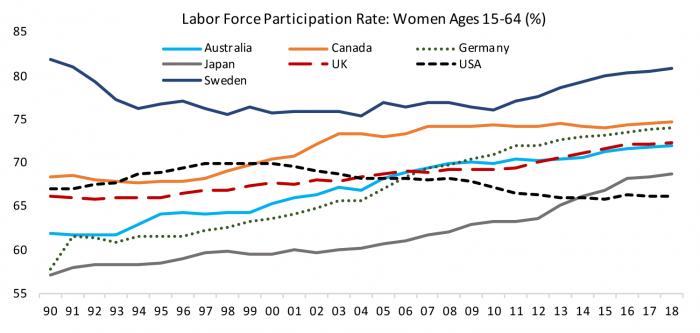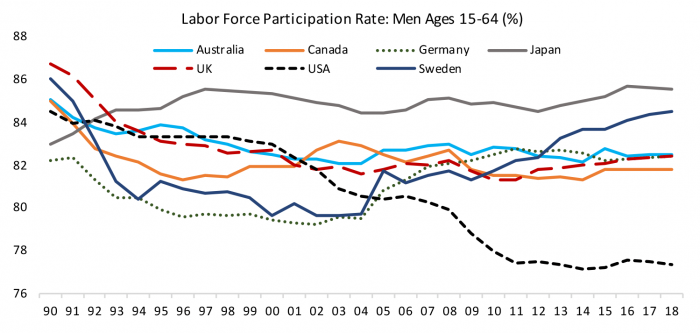
The trends and drivers of US Labor Force Participation say ‘maybe.’
Nearly all countries are seeing population growth slow and populations age reflecting declining birth rates and longer life expectancies. These trends reflect many positive developments in health, education and economic well-being, but they also pose challenges to maintaining and improving living standards further. One building block of ensuring economic prosperity amid current demographic trends is facilitating labor force participation of women and men in their prime working years. Since the peak of prime aged participation in the US in the late 1990s, the US has bucked international trends and registered declining participation. The US has gone from having some of the highest prime-aged participation among women and men to having among the lowest. One reason appears to be a relative lack of policies that help firms and workers manage work and family responsibilities in the US. Other reasons are complex and can include rising opioid addiction and changing educational enrollment patterns. As the job market has continued to recover from the Great Recession, the US has seen a surprising and welcome rebound in the labor force participation of prime-aged women and men suggesting that further recovery is possible. Raising labor force engagement would improve growth prospects and help the US meet the demands of an aging population.
The two building blocks of growth are expansions in the labor force and productivity. While we tend to think of labor force growth mainly in terms of birth rates among the domestic population and immigration, the rate at which residents decide to participate or not in the labor force varies widely across countries and over time and can have a material impact on a country’s growth prospects. Slower population growth reflecting lower birth rates is a global phenomenon that is expected to lead to slower overall economic growth rates. However, the number of people engaged in the formal workforce varies substantially across countries and over time can affect economic growth prospects. The US has bucked international trends toward higher labor force participation (LFP) and has seen declines in participation of women and men in their prime working years.
Figure 1: US Has Seen A Steep Decline in Labor Force Participation
The US has gone from a labor leader to a laggard
The US has seen a steep drop in labor force participation in the past two decades. The share of people over 16 years of age either employed or looking for work peaked in the late 1990s at just over 67% and has since declined to a low of 62.7% in 2015 through 2017. Last year the participation nudged up to 63.1% in a hopeful sign that the labor market is strong enough to pull people back into the labor force. To add some perspective, in terms of today’s population the 4.5 percentage point decline in LFP means more than 11.5 million people aren’t participating in the labor market.
A good portion of the decline in overall labor force participation in the US can be explained by the aging of the Baby Boom generation; as this large generation transitions into retirement the natural implication is that a smaller share of the population will be engaged in the labor force. However, there are other trends at play for people in their prime working years defined by the International Labor Organization as ages 15 to 64 which will be my focus here. Figure 1 illustrates that the US went from having one of the highest LFPs for prime-aged workers in 2000 among advanced economies to among the lowest. Furthermore, LFP in the US is trending lower while other countries are seeing steady upward trends in LFP. Since 2000 the countries shown in the chart have seen an average increase of 5 percentage points in prime age LFP while the US has seen participation decline by 6 percentage points.
The Recipe for Rising Female Participation in the US Isn’t Rocket Science
Prime-aged LFP has been declining for both men and women in the US in recent decades. Figure 2 shows prime-aged LFP across the same group of advanced countries for women. Women had started participating in the labor force at increasing rates starting in the 1960s with LFP reaching a peak and leading advanced economies in 2000. Since then LFP has declined by 5 percentage points in the US but risen steadily in other countries. Even Japan which has had lower female participation for decades has put in a set of policies to encourage the participation of women. Those policies have found traction and the LFP rate of Japanese women now exceeds the US by 2.6 percentage points. The LFP of women is influenced by a number of economic, technological and cultural factors, an excellent review of which can be found in Our World in Data. Over the past century advances in maternal health including access to birth control, the availability of labor-saving consumer durables like household appliances, changing social norms, and the shift toward a service sector economy have contributed to a substantial increase in the participation of women in the formal workforce. The trend toward increased participation began in the more advanced, wealthier nations but some less developed nations have seen a rapid catch up and convergence toward higher rates of female participation over the past twenty years.
Figure 2: Prime Age Women in the US Are Bucking International Trends
Research also finds causal evidence that expansions of maternity leave and other family friendly policies in a number of the countries included in Figure 2 have contributed to rising labor force participation among women. The US lags far behind most other advanced nations in requirements and public subsidies for family friendly benefits. For example, mothers are entitled to 18 weeks of paid maternity leave across OECD countries and almost all OECD countries offer paid maternity leaves lasting at least three months. The United States is the only OECD country not to offer statutory entitlement to paid leave on a national basis.[1] As of 2013, the governments of the countries in Figure 2 spent an average of 2.5% of GDP on subsidizing or providing access to family benefits versus 0.7% of GDP in the US. It isn’t exactly rocket science that more generous provision of family benefits could help prompt increased LFP among women in the US as it has in many other countries.
Declining Male Labor Force Participation is Structural and Cyclical
The US has also seen a sobering contrast to other advanced countries in the prime-aged participation of men. Figure 3 illustrates that in 2000 the LFP of men in the US was at the upper end of other advanced economies. Since then participation rates in the US have dropped 7 percentage points versus an average gain of 2 percentage points among the other countries in the chart. The trend toward lower participation among prime-aged men has been ongoing since the 1950s when LFP averaged 97% for men aged 25 to 54 until today when it has averaged 88.6% over the past ten years for this narrower definition of prime-aged workers. Some of the secular trend reflects increased prosperity that has meant men and women tend to work less when they are enrolled in school and they can retire earlier (although there are indications the trend toward earlier retirements is starting to reverse). Research that has focused on the decline in male LFP since 2000 has concluded that rising opioid dependency can account for as much as 43% of reduced participation and that for young men in particular increased time spent playing video games may be contributing to reduced participation.
Figure 3: Prime Age Men in the US Are Participating at Record Low Rates
The Federal Reserve Bank of Atlanta recently created a user-friendly tool that decomposes changes in LFP over time according to the various reasons respondents to detailed household level surveys give for nonparticipation in the labor force. Figure 4 illustrates the results of the decomposition for men aged 25 to 54. Since 2000 the LFP for this group has declined by as much as 3.2 percentage points in 2013 though 2015, although there has been a notable recovery in recent years so that as of the end of 2018 participation was 2.3 percentage points lower. As of 2018 the two largest contributors to reduced prime aged LFP among men are having family responsibilities that kept them out of the labor force being and being enrolled in school. Family responsibilities explains 0.7 percentage points of reduced participation, a contribution that has grown over time and may reflect a greater propensity among younger men to stay home and care for young children, as well as a need to care for aging parents. Increased enrollment in school accounts for 0.6 percentage points of reduced participation and has also increased over time.
There are two categories that are tied to the broader health of the macro economy. One is the shadow labor force, which is defined as people who are not participating but who say they want to work and would work if there was a job available. The shadow labor force contributed to as much as 0.7 percentage points of male non-participation in the aftermath of the Great Recession but only 0.3 percentage points as of 2018. Men not working due to disability or illness also appears to be fairly cyclical as it accounted for as much as 1.3 percentage points of non-participation but only 0.25 percentage points in 2018.
Figure 4: Decline in LFP Among Prime Age Men Influenced by Multiple Factors
The contributors to the reduction of prime-aged LFP among men is further decomposed by race or ethnicity in Figure 5. White men have seen the largest declines in LFP (2.4pp) and black men the least (1.1pp). White and black men have seen the largest declines due to increased family responsibilities while increased enrollment in school explains two thirds of the reduction in participation among Hispanic men. While increased disability relative to 2000 is still a drag on participation for white men, it has declined sharply for black and Hispanic men such that it suggests increased participation over this time period that has been offset by other factors for the groups as a whole.
Figure 5: Decline in LFP Among Prime Age Men Influenced Varies by Race/Ethnicity
Prime-aged LFP in the US lags behind other countries but has staged a surprising and welcome rebound of late. LFP among men aged 25 to 54 rose 0.8 percentage points between 2015 and 2018 as the labor market strengthened and recovered from the Great Recession, while women in the same aged group saw a robust 2.0 percentage point rebound and have fully recovered the losses of the Great Recession. Officials at the Federal Reserve have cited rebounding LFP as one reason they are less concerned about economic overheating, allowing them to be more patient on interest rates. Macroeconomic policy can only do so much, however. Policies that make it easier for people to take care of family responsibilities would likely help both women and men, as well as policies that allow people to combine education and training with work. Most countries are facing rising dependency ratios, defined as the share of the population not working relative to the share working, due to aging populations. One building block of ensuring economic prosperity amid current demographic trends is facilitating the labor force participation of prime-aged women and men, and there is plenty of scope for improvement in the US.
[1] See the OECD Family Database.




